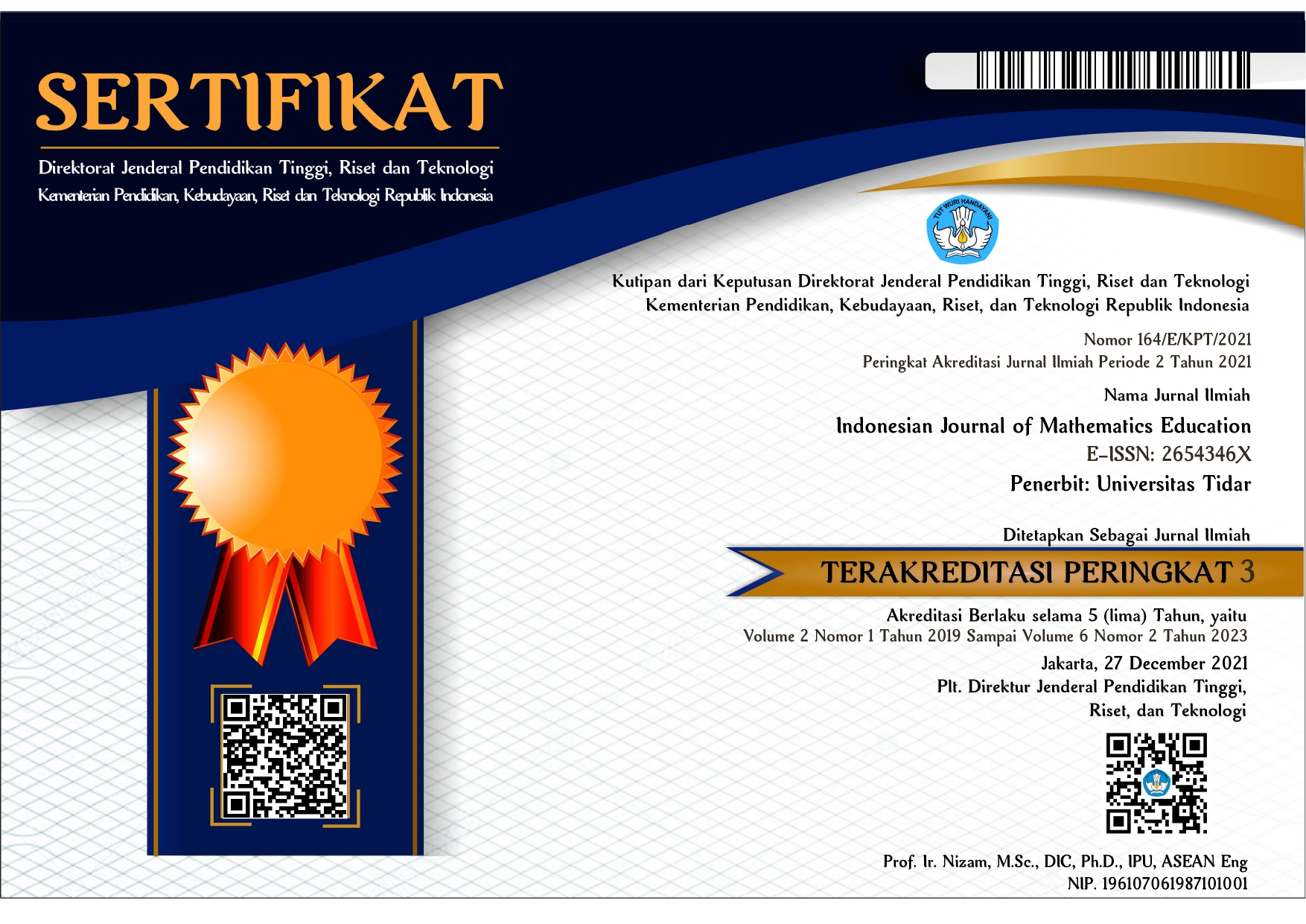Students’ Combinatorial Thinking Error in Solving Combinatorial Problem
Keywords:
Combinatorial Thinking, ErrorAbstract
Combinatorial thinking errors describe students’ difficulties and obstacles in solving combinatorial problems. This study aims to describe the errors experienced by students in solving combinatorial problems in terms of combinatorial thinking processes. This research involved two subjects who were 12th grade high school students at a school in Gresik, Indonesia. The students have already taken a combinatorics course. Data collection was conducted using the think-aloud observation method and task-based interviews. Both methods of data collection were conducted to validate the data using the triangulation method. The two subjects experienced similar errors. The research shows that the filling slots method is a simple and easy way for students to understand, but problems arise when students cannot understand the meaning of the questions and input the correct numbers for the problem. The combinatorial thinking error includes the general counting process and vertical upward formulas or expressions. The general counting process error is generating a number that represents the given aspects of the problem and the vertical upward formula/expression is identifying the concept that fits the problem. This research suggests enhancing students understanding of number representation when teaching the filling slot method. The teacher should illustrate some of the multiplication rule and addition rule examples to help students distinguish between these two fundamental rules. Further research is needed to provide solutions to the constraints experienced by students in solving combinatorial problems.
References
Aini, N., Juniati, D., & Siswoyo, T. (2018). Understanding the combinatorial thinking through the strategy used by students cognitive reflective in solving permutation. International Conference on Mathematics and Science Education, 3, 652–657.
Ammamiarihta, A., Syahputra, E., & Surya, E. (2017). Development of Learning Devices Oriented Problem Based Learning to Increase Student’s Combinatorial Thinking in Mathematical Problem Solving Ability. Advances in Social Science, Education and Humanities Research, 104(Aisteel), 334–339. https://doi.org/10.2991/aisteel-17.2017.71
Astuti, R., Matematika, P., Muhammadiyah, S., & Lampung, P. (2017). Analisis Learning Obstacles Mahasiswa Dalam Mempelajari Materi Kombinatorial. Jurnal Edumath, 3(1), 56–64. http://ejournal.stkipmpringsewu-lpg.ac.id/index.php/edumath
Dwinata, A. (2019). Analisis Kemampuan Pemecahan Masalah Menggunakan Pemodelan RASCH pada Materi Permutasi dan Kombinasi. PRISMA, Prosiding Seminar Nasional Matematika, 2, 124–131. https://journal.unnes.ac.id/sju/index.php/prisma/article/view/28899
Hidayati, Y. M., Ngalim, A., Sutama, Arifin, Z., Abidin, Z., & Rahmawati, E. (2020). Level of combinatorial thinking in solving mathematical problems. Journal for the Education of Gifted Young Scientists, 8(3), 1231–1243. https://doi.org/10.17478/JEGYS.751038
Hidayati, Y. M., Sa’dijah, C., & Subanji, A. Q. (2019). Combinatorial thinking to solve the problems of combinatorics in selection type. International Journal of Learning, Teaching and Educational Research, 18(2), 65–75. https://doi.org/10.26803/ijlter.18.2.5
Lockwood, E. (2013). A model of students’ combinatorial thinking. Journal of Mathematical Behavior, 32(2), 251–265. https://doi.org/10.1016/j.jmathb.2013.02.008
Medová, J., Bulková, K. O., & Čeretková, S. (2020). Relations between generalization, reasoning and combinatorial thinking in solving mathematical open-ended problems within mathematical contest. Mathematics, 8(12), 1–20. https://doi.org/10.3390/math8122257
Miles, M. ., & Huberman, M. (1984). Qualitative Data Analysis. Sage.
Rezaie, M., & Gooya, Z. (2011). What do I mean by combinatorial thinking? Procedia - Social and Behavioral Sciences, 11, 122–126. https://doi.org/10.1016/j.sbspro.2011.01.046
Salavatinejad, N., Alamolhodaei, H., & Radmehr, F. (2021). Toward a model for students’ combinatorial thinking. Journal of Mathematical Behavior, 61(October 2019), 100823. https://doi.org/10.1016/j.jmathb.2020.100823
Sinaga, N. Y., Siagian, M. V, & Hasibuan, A. M. (2021). Kesulitan Siswa SMA Dalam Menyelesaikan Soal Cerita Matematika Materi Peluang. ALGEBRA, 1(1), 6–13. https://ejurnal.seminar-id.com/index.php/bulma/article/view/870
Siswono, T. Y. E. (2019). Paradigma Penelitian Pendidikan : Pengembangan Teori dan Aplikasi Pendidikan Matematika. Remaja Rosyda Karya.
Uripno, G. (2020). Kesalahan Berpikir Kombinatorik Siswa dalam Menyelesaikan Masalah Kombinatorik. Universitas Negeri Surabaya.
Uripno, G., & Rosyidi, A. H. (2019). Students’ Combinatorial Thinking Processes in Solving Mathematics Problem. Jurnal Riset Pendidikan Dan Inovasi Pembelajaran Matematika (JRPIPM), 2(2), 80. https://doi.org/10.26740/jrpipm.v2n2.p80-92
Wu, H., & Molnár, G. (2018). Interactive problem solving: Assessment and relations to combinatorial and inductive reasoning. Journal of Psychological and Educational Research, 26(1), 90–105.
Published
How to Cite
Issue
Section
Copyright (c) 2023 Indonesian Journal of Mathematics Education

This work is licensed under a Creative Commons Attribution-NonCommercial-ShareAlike 4.0 International License.









